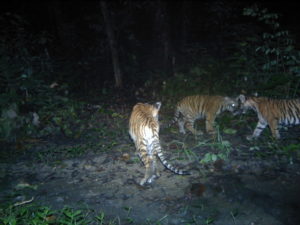On 3rd March 1973, the Convention on International Trade in Endangered Species of Wild Fauna and Flora (CITES) was signed and in 2013 the United Nations declared that this day would become World Wildlife Day to celebrate and raise awareness of the world’s wild animals and plants.
World Wildlife Day is celebrated in 2021 under the theme Forests and Livelihoods: Sustaining People and Planet, to highlight the role of forests, forest species and ecosystems services in sustaining the livelihoods of hundreds of millions of people globally, and particularly of Indigenous and local communities with historic ties to forested and forest-adjacent areas. This aligns with UN Sustainable Development Goals 1, 12, 13 and 15, and their wide-ranging commitments to alleviating poverty, ensuring sustainable use of resources, and conserving life on land.
We are delighted to share this blog from Shashanka Sharma, Programme Officer at ZSL Nepal which has been supported in Parsa National Park by WildCats Conservation Alliance since 2014.
Forests and Livelihoods: Sustaining people and planet – World Wildlife Day 2021
Forest ecosystems are crucial to the livelihood of people. In Nepal, people depend on the forest to meet their needs for food, energy, and medicine. On a broader scale, forests serve as the foundation for other ecological services such as climate regulation and maintaining hydrological cycle. It is therefore essential to ensure that the forests remain resilient, so that the flow of ecological services is sustained, which in turn not only contributes to the wellbeing of the communities living at the edges of the forest, but for the general population as well.
Nepal’s Chitwan-Parsa complex, which comprises nearly 2000 sq. km of contiguous habitat is home to nearly 600 rhinos, 110 breeding tigers and a myriad of other wildlife. Parsa National Park (PNP), which is a part of the complex, used to serve as the sink for tiger and rhino population of Chitwan National Park. However, increasing impact from the joint conservation interventions undertaken by the Government of Nepal and its conservation partners have transformed PNP, evidenced by the fact that the tiger numbers nearly grew threefold from 2014 to 2018 (7 to 18 tigers). Increasing the density of the prey base within the park through habitat management including wetland and grassland management was one of the key components to achieving this success. ZSL worked with the Department of National Parks and Wildlife Conservation (DNPWC) to restore one of the most important wetlands within the park, the Halkhoriya lake, which had been heavily deteriorated. This lake, spread over 15 ha, is a key wetland in an otherwise dry landscape of PNP, providing valuable water for wildlife and helping minimise wildlife from plundering nearby settlements. Similarly, ZSL also supported to maintain 22 ha of grassland within the park.
Over the wider landscape in Nepal, increases in wildlife has often meant that associated human wildlife conflict has also risen. With the increase in tiger number in PNP, human tiger conflict (HTC) is projected to increase in the buffer zones of the park. Over the years ZSL has worked in the lowland tiger bearing PAs of Nepal, we have worked with the DNPWC to safeguard vulnerable communities against HTC. One of the mechanisms through which ZSL is safeguarding people’s livelihood in the buffer zone of PNP is through Predator Proof Corrals (PPC) with help from WildCats Conservation Alliance. These help secure livestock from tigers and other large carnivores. Since livestock farming is an important source of revenue for the vulnerable HHs residing in the buffer zone, PPCs have become indispensable. Similarly, we continue to work with buffer zone communities to raise awareness regarding HTC mitigation, access to relief mechanism and the responsibilities of communities in tiger conservation. These awareness programmes have now reached more than 2000 people, with several information boards installed around the vicinity of the park spreading conservation knowledge to wider audiences. Similarly, ZSL has also supported communities to engage in tiger conservation through the formation of Community Based Anti-Poaching Unit (CBAPU). CBAPUs routinely monitor illegal activities within their buffer zone forests, alerting park officials to any untoward activities. Information from CBAPUs have enabled park officials to confiscate different weapons and arrest would be smugglers/poachers.
All these interventions have served to empower communities to take stewardship of conservation initiatives, while providing a platform for improved coexistence with wildlife, including the tiger. Improving human wildlife coexistence is an important factor in safeguarding not only wildlife, but also the livelihoods of the people. This way, we can ensure that the livelihoods of the most vulnerable are not jeopardized, which is essential to fostering support for conservation. Only when the livelihoods of the people are secured, can the forest be saved. Only when the forest is saved, can the tiger flourish!

Three cubs in Parsa National Park 2020 © ZSL

Hakhoriya Lake before restoration © ZSL

Halkhoriya Lake after restoration © ZSL

Fostering community stewardship © ZSL

